Author: Andrew Hong; Translator: Ladyfinger, blockbeats
Editor's Note:
This article delves into the behavior and impact of meme coins in the current market, revealing the diversified performance and investment potential of this type of cryptocurrency through a detailed analytical framework. The data and charts in the article are derived from a data set compiled specifically for Farcaster meme coins, providing a comprehensive perspective to help readers understand the community and financial performance of meme coins. By combining community data with financial data, the author attempts to make a more scientific assessment and classification of such tokens, thereby providing decision support for investors and analysts.
Introduction
Every market cycle is accompanied by the emergence of meme coins. If you are not familiar with the concept, think of the craze that drove AMC's stock price up in the 2021 reddit forum. A group of people push the price of an asset higher in a short period of time (ranging from a day to a few months) around a meme. This has become a popular market strategy in the crypto space from the blockchain layer to the application layer, because people are not only driving the price, but also the attention of an ecosystem. Some projects like Avalanche even go a step further and create an official foundation for meme coins.
The difference between a meme coin and any other token may not be very clear, but usually, there is nothing backing the token except the meme image itself. For example, DOGE is a token that is really backed by the Shiba Inu image, unlike ETH, which is secured by the Ethereum blockchain, UNI, which is backed by the full Uniswap protocol, or MKR, which is backed by a full collateral stablecoin service.
Farcaster meme coins (such as DEGEN) are the latest trend, and their main advantage is that their community is publicly accessible. Therefore, I want to do some basic analysis combining community and financial data.
How to evaluate a meme coin
We can use the following chart to divide all meme coins:
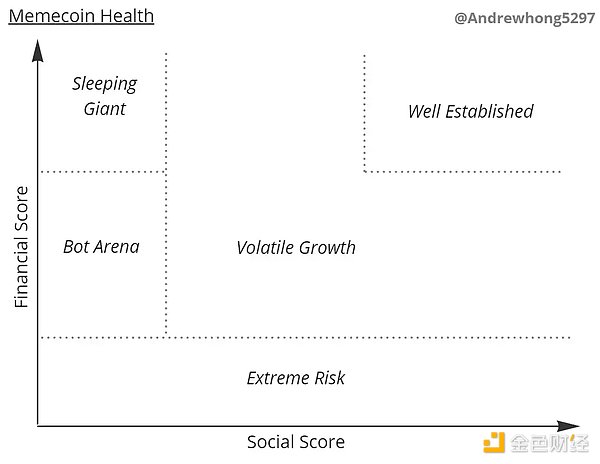
The above chart is divided into five main areas:
· Extreme Risk: meme coins with low liquidity and trading volume are very dangerous and easy to be RUG because there are too few liquidity providers
· Bot Arena: Most meme coins will never break out of the war because thousands of currencies, and even many meme coins with the same or similar token names, are competing for the attention of the community and assets
· Volatile Growth: Those meme coins that break out of their initial period need to maintain their momentum and growth. During this period, you may see price fluctuations of 100-500%, whether the fluctuation is upward or downward, there will be many KOLs starting to catch the meme.
· Well Established: The leader in the meme coin market will occupy a high position in community attention and financial value for a period of time, forming a clear gap with other competitors. This leading state may be manifested as less price fluctuations, showing a kind of stability, because the number of new investors interested in the meme coin has reached a balance with the number of investors exiting, thus maintaining the continued attention on the meme coin.
· Sleeping Giant: A meme coin that has grown a lot in both community and funding and has not suffered "RUG" may be temporarily silent. It is very likely that a DAO has been formed, and they are starting to launch minting or products and deal with the chaos in the community while hoping to be noticed again.
Most meme coins should be trapped in the "Bot Arena", some eye-catching meme coins are in the "Volatile Growth" section, and perhaps one or two meme coins can become "Well Established." In the process, some may lose community power and become "Sleeping Giants", while others may lose liquidity and become "Extreme Risk."
The roadmap of a successful meme coin should be like this:

You may see that many meme coins have received a lot of media attention due to the promotion of bots or KOLs, but in fact their liquidity is not strong, which may put investors at risk of being "RUG", that is, if the project party suddenly withdraws the liquidity, investors will suffer losses.
After a lot of data analysis, I made a chart related to the Farcaster meme coin on Dune:
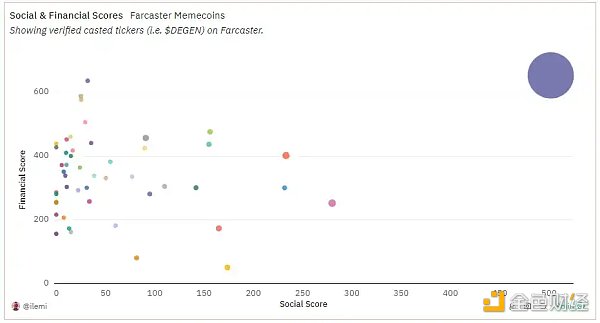
This is actually very consistent with my expectations. You can see that DEGEN is at the far end of the upper right corner, and then some others like ENJOY, HIGHER, TN100X and EVERY are in the middle. Other meme coins are trapped on the left side, competing for attention and liquidity.
It is worth noting that I did not filter out Sybil attacks or bots here, so the community scores of some meme coins may be biased. This is a direction that can be improved in the future.
Now, let’s explain how the two scores were generated from this final chart. I will also pose further research questions and explain my logic in detail for those who want to dig deeper.
There are also some charts that I didn’t list in this article, which can be found here.
Community Scores
Each score consists of a “base” component and a “growth” component. For the community score, we first measure the delivery and participation of token mentions. Therefore, according to this method, “$DEGEN” will be counted, but “DEGEN” will not. Symbols related to the token, such as degen hat, higher arrow, tn100x ham, will also be counted in the total.
This gives us five main metrics:
· Senders: The number of people who have spun a particular token
· Receivers: The percentage of those spunters who have previously received that token
· Number of Shots: The number of shots that have contained a particular token
· Number of Channels: The number of channels that have had shots containing a particular token
· Activity Level: Engagement (likes + replies) plus the number of shots times the cube root of the number of shooters times the cube root of the number of channels.
The overall community score is calculated using a “base” activity level and a “growth” multiplier based on the weekly change in unique shooters and receivers. Essentially, if we see more and more people spun a token, and those people are finding ways to own those tokens, that’s definitely a very healthy sign.
Overall, it looks like this in the table:
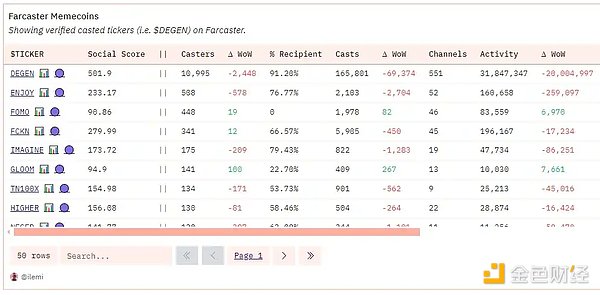
Funding Score
Here are several financial indicators:
· Fully Diluted Value (FDV): fully diluted price, total supply x price
· Price: the latest price based on DEX transactions
· Daily, weekly, monthly price change percentage: the percentage change of price on a daily, weekly, and monthly basis
· Liquidity: This liquidity refers to non-token liquidity, which means that for a DEGEN-WETH (Ethereum) pool, we only count the WETH portion of it. Doing so gives us a more stable signal of how much good liquidity a given token has.
· Volume: DEX trading volume in the past 30 days
· Transfer volume: ERC20 transfers in the past 30 days
· Total volume: USD trading volume on DEX in the past 7 days
The "base" part of the financial score is determined by its non-token liquidity and DEX trading volume, while the "growth" part is calculated based on the week-on-week change in liquidity. All in all, it looks like this in a table:
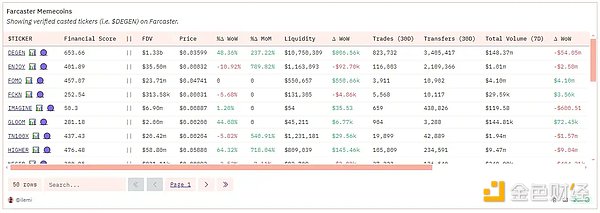
Follow-up questions
Here are some questions I hope to explore in depth from here:
· How to score "dumpers" for Sybil attacks or bot behavior based on the value of tokens held in their wallets?
· Can "dumpers" be graded based on their relationship with known groups or communities?
· How are the stages of community and financial growth categorized? How are they related? Is there a time lag or mutual dependence?
· Are the same groups of people or types of people driving the initial growth phase? What are the characteristics of those who join a meme first, just in time, and last? How does this relate to the level of users?
· What are the driving factors behind a meme as it moves from one hot spot to another?
· How is a person's level of interest assessed based on their investment in the community or finances? Do people change their "investment" behavior after buying or selling a specific token?
· What is the average lifespan of a meme at the community and financial level?
Data Query Guide
While all the output here looks like it comes from a single dataset, the data behind the scenes is actually a bit more complex. You can query the relevant data according to the following guidelines:
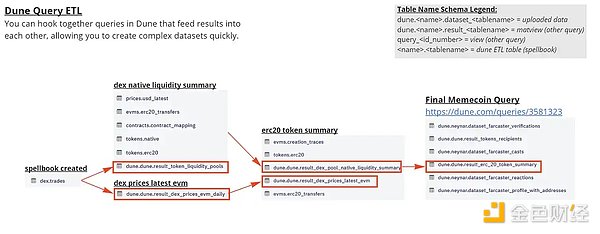
· dune.neynar...... "The dataset was uploaded by Neynar's team, which indexed all Farcaster data. If you are not familiar with the concept of Farcaster data, start with my beginner's guide. Generally speaking, if you see "dataset" in the tab name, it means that it was uploaded by the team name displayed after the "dune." prefix.
· Whenever you see "result" in the table name, it is a matview. I created the "erc20 token summary table" to get all the trading, price, liquidity, and transfer data for a specific token. This summary table was further broken down in subqueries, so the final query took only 3 minutes to run. The total run time for all queries takes about 60-70 minutes.
· If you see a table name that does not follow the prefix above (and is not a raw or decoded table), then it is most likely from spellbook. So tokens.erc20 gives me all tokens with a symbol or decimal, dex.trades gives me all DEX trades on all blockchains, etc. You can search the github repo for table namespaces or table names (such as "dex" or "trades") to find the logic of the tables.
Summary
As a unique type of cryptocurrency, meme coins are often strongly influenced by community media and community dynamics. In addition to proposing a systematic framework for evaluating meme coins in the article, through data analysis built on the Dune platform, we can more accurately monitor and predict the performance of these tokens.
Although there are certain challenges, such as the potential risk of Sybil attacks or Bot manipulation, the analysis of meme coins can be more precise and practical through continued monitoring and technical improvements. Future research may further deepen the understanding of these complex factors and bring new insights to the broad field of cryptocurrency.
 JinseFinance
JinseFinance
 JinseFinance
JinseFinance JinseFinance
JinseFinance JinseFinance
JinseFinance JinseFinance
JinseFinance JinseFinance
JinseFinance JinseFinance
JinseFinance JinseFinance
JinseFinance JinseFinance
JinseFinance CryptoSlate
CryptoSlate JinseFinance
JinseFinance